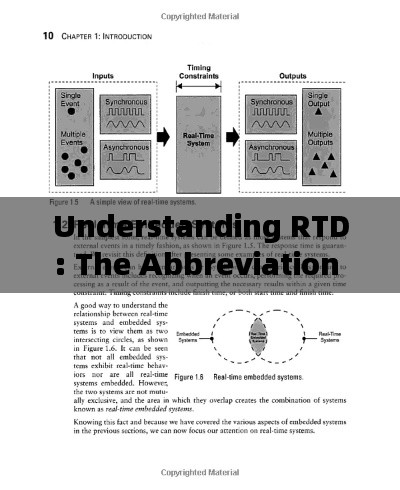标题:Understanding RTD: The Abbreviation for Real-Time Temperature
Introduction: Real-time temperature monitoring is crucial in various industries, including manufacturing, healthcare, and research. The abbreviation RTD, which stands for Resistance Temperature Detector, is widely used to refer to this technology. In this article, we will explore the concept of RTD, its working principle, applications, advantages, and disadvantages.
What is RTD? RTD is a type of temperature sensor that measures temperature by detecting changes in resistance. It consists of a thin wire made of a material with a high positive temperature coefficient (PTC) or negative temperature coefficient (NTC). As the temperature changes, the resistance of the wire also changes, and this change is converted into an electrical signal that can be measured and displayed.
Working Principle: The working principle of an RTD is based on the fact that the resistance of most metals increases with temperature. When the temperature increases, the atoms in the metal vibrate more, which increases the resistance of the wire. Conversely, when the temperature decreases, the resistance decreases. This change in resistance is directly proportional to the temperature change.
Types of RTDs: There are several types of RTDs, each with its own characteristics and applications. The most common types are:
-
Platinum RTD (PT100, PT1000): Platinum is the most commonly used material for RTDs due to its high accuracy and stability over a wide temperature range (-200°C to +850°C).
-
Nickel RTD (Ni100): Nickel RTDs are less common than platinum RTDs but are used in applications where nickel is more suitable, such as in the food and beverage industry.
-
Copper RTD (Cu50): Copper RTDs are less accurate and stable than platinum and nickel RTDs but are used in applications where cost is a significant factor.
Applications: RTDs are used in various industries for temperature measurement and control. Some common applications include:
-
Industrial processes: RTDs are used to monitor and control temperatures in manufacturing processes, such as in the production of chemicals, plastics, and metals.
-
HVAC systems: RTDs are used to monitor and control temperatures in heating, ventilation, and air conditioning systems.
-
Research and development: RTDs are used in research and development to monitor temperatures in experiments and tests.
-
Healthcare: RTDs are used in medical devices and equipment to monitor patient temperatures and ensure proper operation.
Advantages of RTDs: RTDs offer several advantages over other temperature sensors, such as:
-
High accuracy: RTDs are highly accurate and can provide precise temperature measurements.
-
Wide temperature range: RTDs can operate over a wide temperature range, making them suitable for various applications.
-
Stability: RTDs are stable over time and can maintain their accuracy for long periods.
-
Non-electromagnetic interference: RTDs are not affected by electromagnetic fields, making them suitable for use in sensitive environments.
Disadvantages of RTDs: Despite their advantages, RTDs have some disadvantages, such as:
-
Cost: RTDs can be more expensive than other types of temperature sensors, especially platinum RTDs.
-
Slow response time: RTDs have a slower response time compared to some other types of temperature sensors, such as thermocouples.
-
Susceptible to vibration: RTDs can be sensitive to vibration, which may affect their accuracy.
Conclusion: RTD is a reliable and accurate temperature sensor used in various industries. Its working principle, types, applications, advantages, and disadvantages are discussed in this article. Understanding RTD can help engineers and technicians select the appropriate sensor for their specific needs and ensure accurate temperature measurement and control.
Word Count: 812
Unlocking the Power of Real-Time Stock Data: Understanding the Abbreviation
Title: "Rainy Weather Alert: Navigating the Downpour with Real-Time Updates"
Title: "Mastering the Art of Advertising: Top Hot Advertising Cases Analyzed"
Title: "Navigating the Fast-Paced World: Embracing the Real-Time Dynamics"
《The Phenomenon: Unveiling the Magic of a Blockbuster Hit》
Title: "Global Gourmet: Exploring the Trending Food Topics of Today"
Title: "COVID-19 Real-Time Updates: Global Pandemic Dynamics and Latest Developments"
Title: "Real-Time Traffic Monitoring: Enhancing Urban Mobility with Advanced Technologies"











 京ICP备19050683号-2
京ICP备19050683号-2